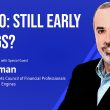by Brian Wesbury, Chief Economist, and Robert Stein, Deputy Chief Economist, First Trust Portfolios
When fourth quarter GDP data is released later this week, it will show that 2021 finished on a high note. Unfortunately, the high note included not only strong economic growth but also rapid inflation. This shouldn't be a surprise; it's what you get when you mix a huge surge in government spending with very loose monetary policy.
At present, we estimate that real GDP grew at a 5.7% annual rate in the fourth quarter. If we're right, then real GDP grew 5.2% in 2021 (Q4/Q4), the fastest pace for any calendar year since the Reagan Boom in 1984. However, that rapid growth follows a 2.3% contraction in 2020. As a result, real GDP at the end of last year was up only 1.4% annualized versus the end of 2019 (the last quarter before COVID). That's slower than the pre-COVID trend in economic growth, which means that in spite of the fastest growth in decades last year, the economy remains smaller than it would have been if COVID and all the related lockdowns hadn't happened. Glass half-full, glass half-empty.
The same can't be said about inflation, which is clearly higher than the pre-COVID trend. We estimate that GDP prices rose at a 5.9% annual rate in the fourth quarter, which would bring the 2021 (Q4/Q4) increase to 5.6%, the highest inflation for any calendar year since 1981. That follows a moderate 1.5% gain in 2020.
Bear in mind that we get a report on Wednesday that will tell us about inventories and international trade in December, and those figures may change our projections a little. But, as of now, here's how we get to our 5.7% real GDP growth forecast for the fourth quarter.
Consumption: Car and light truck sales fell at a 15.5% annual rate in Q4, largely due to continued supply-chain issues. However, "real" (inflation-adjusted) retail sales outside the auto sector rose at a 1.0% rate and it looks like real services spending should be up at a solid pace. Putting it all together, we estimate real consumer spending on goods and services, combined, increased at a moderate 2.0% annual rate, adding 1.4 points to the real GDP growth rate (2.0 times the consumption share of GDP, which is 69%, equals 1.4).
Business Investment: The fourth quarter should show slight growth in both business investment in equipment as well as commercial construction, while investment in intellectual property rose at a typically strong rate. Combined, business investment looks like it grew at a 5.3% annual rate, which would add 0.7 points to real GDP growth. (5.3 times the 13% business investment share of GDP equals 0.7).
Home Building: Residential construction looks like it slowed slightly in the fourth quarter. That's not due to less demand – sales are trending higher and inventories remain very low – but instead reflects supply-chain issues and lingering problems finding willing workers. We estimate a contraction at a 4.3% annual rate in Q4, which would cut 0.2 points from real GDP growth. (-4.3 times the 5% residential construction share of GDP equals -0.2).
Government: Remember, only direct government purchases of goods and services (and not transfer payments like unemployment insurance) count when calculating GDP. We estimate federal purchases grew at a 1.1% annual rate in Q4, which would add 0.2 points to real GDP growth. (1.1 times the 18% government purchase share of GDP equals 0.2).
Trade: Imports and exports have both recovered but imports have recovered faster, which should result in a slightly larger trade deficit in Q4. At present, we're projecting that the increase in imports relative to exports will subtract 0.1 points from real GDP growth in Q4.
Inventories: Inventories look like they finally started surging in Q4. Inventories are still very low, but they're moving in the right direction. We estimate that the surge will add 3.7 points to real GDP growth.
Add it all up, and we get a 5.7% annualized real GDP growth for the fourth quarter. Look for continued growth in 2022, but not nearly as fast, as the artificial "sugar high" from excessive government spending runs its course.
Brian S. Wesbury – Chief Economist
Robert Stein, CFA – Deputy Chief Economist
Click here for a PDF version
Copyright © First Trust Portfolios














